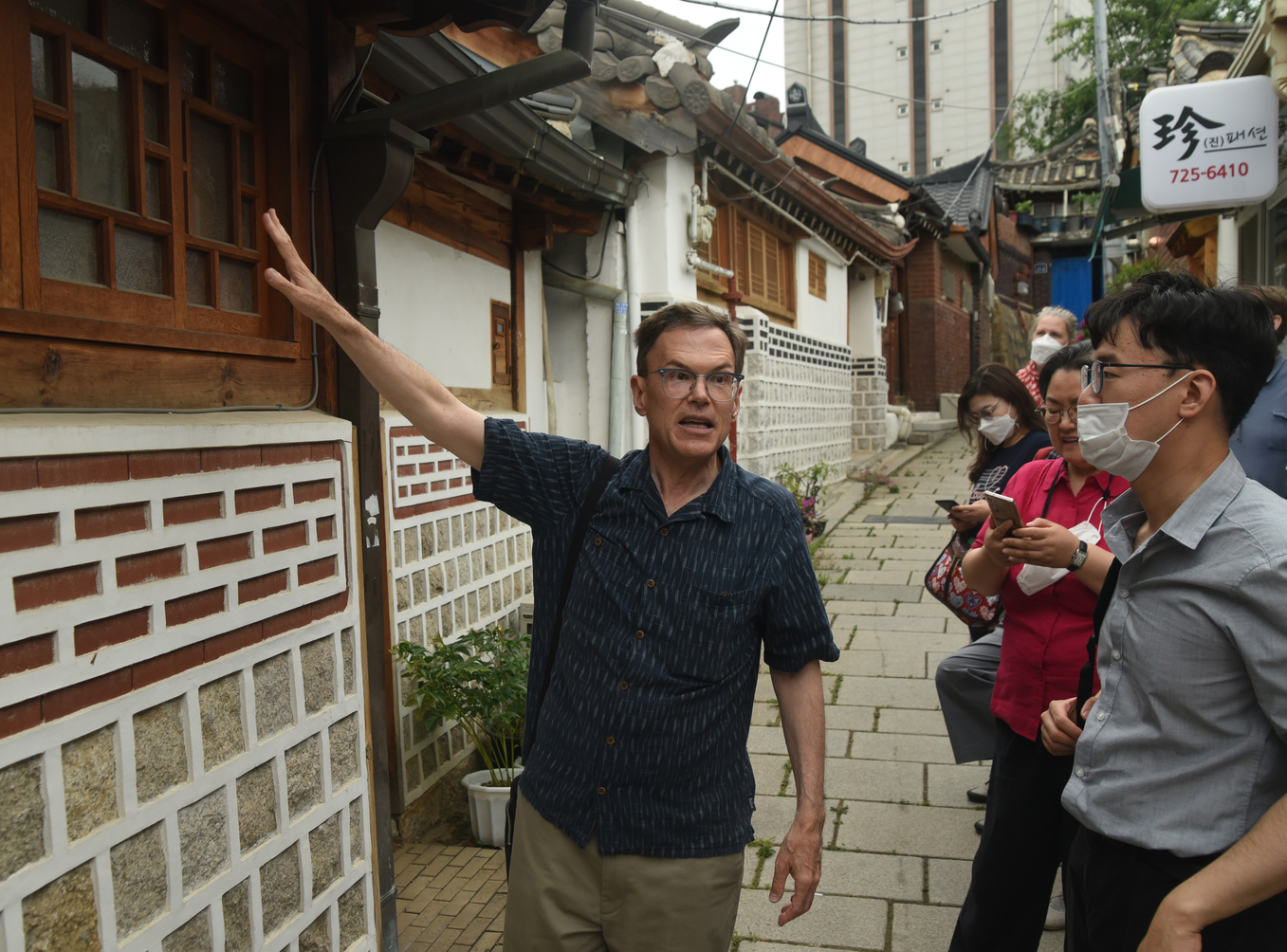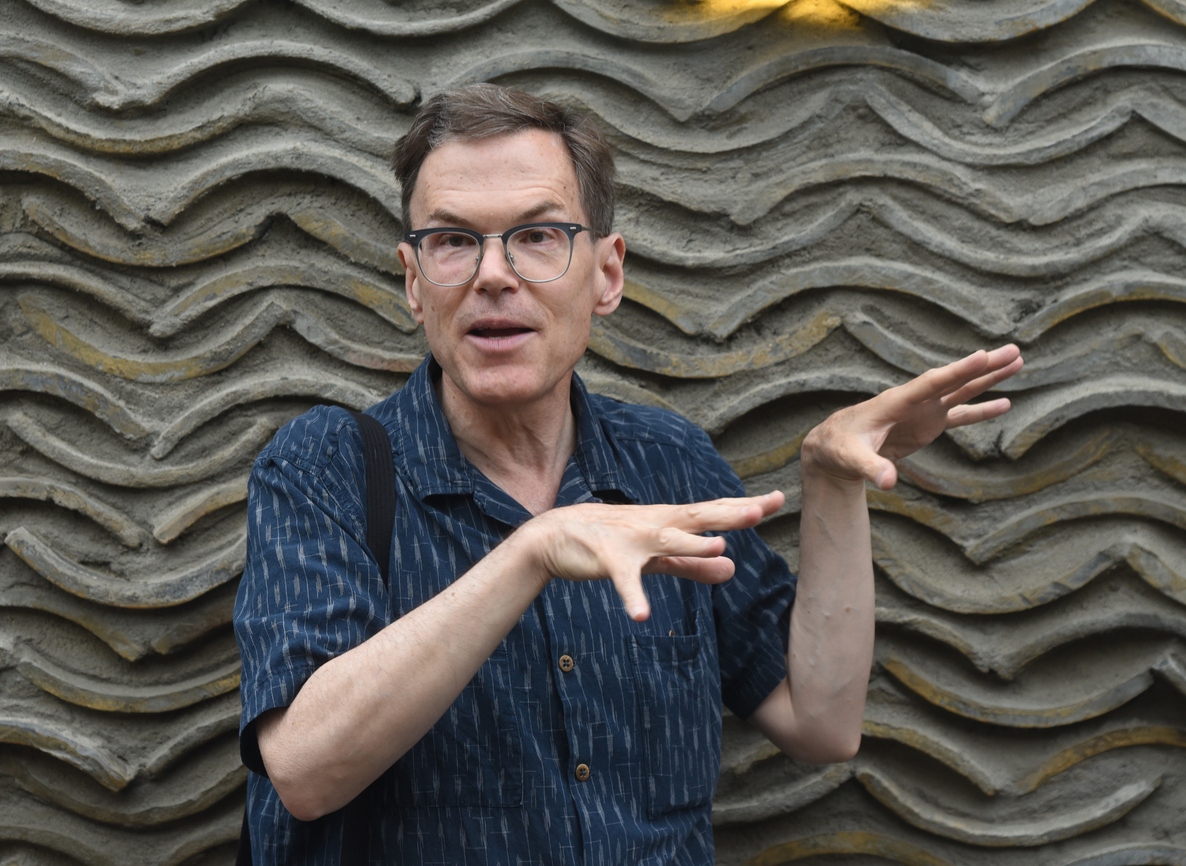[Jun] Robert Fouser shares his love of Korea’s Hanok homes
Date Jun 27, 2022
 Robert Fouser introduces his former Hanok home that he helped renovate in Seochon, central Seoul, June 5.
Robert Fouser introduces his former Hanok home that he helped renovate in Seochon, central Seoul, June 5.
It’s been almost three years since Robert Fouser’s last visit to Korea. Previously, he’d come for a few months a couple times a year, but the pandemic put a stop to that. He returned in May, enthusiastic to be back.
“It feels great to be back, and I'm enjoying every minute,” he said.
Fouser first came to Korea in 1983 as an American student enrolled in the Korean language program at Seoul National University. He became fascinated by Korean traditional architecture, specifically the residential Hanok. He moved into a Hanok for the first time in 1988, in Hyehwa-dong near Seoul’s Daehak-ro theater district.
Asked why he’s drawn to these houses, he gave two main reasons. “The first is aesthetic – the wood, the roof tiles, the windows, the balance, the scale; everything is attractive to me,” he said. “The second is that I like living in them. Hanok are made of natural materials and the air in the winter isn't as dry. The madang (courtyard) brings light and air into the house and you can plant flowers and use it like a terrace. It's a great place to entertain friends. Sure, a Hanok is colder than an apartment on really cold winter nights, but it's not much different from a house in cold parts of North America.”
Since his early years here, Fouser has lived all over. He rented a residence in Bukchon Hanok Village in the early 2010s and later lived for two years in a Hanok in Seochon, whose renovation he oversaw. With the exception of his first Hanok in Hyehwa-dong, the others have featured modern bathrooms and kitchens.
He has also published several books, many written in Korean. The titles include Seochon-holic and Exploring Cities. The latter compares his experiences with urban living in Korea, Japan, the U.S., U.K. and Ireland.
About a month into his latest visit on June 5, he led a Royal Asiatic Society Korea tour through downtown Seoul’s three most prominent Hanok villages: Ikseon-dong, Bukchon Hanok Village and Seochon.
He admitted he hadn’t scouted out the locations prior to taking the group of over 20 foreign residents and Koreans on the afternoon walk. “I didn't do a dry run in advance this time because I wanted to be surprised by changes and to share that surprise with people,” he said.
His biggest surprise came at the first stop on the tour – an alley in Ikseon-dong, where he discovered the Hanok he intended to talk about had been “remodeled beyond recognition” into a cafe.
“I expect surprises because that's one of the defining characteristics of Seoul,” he said.
He recalled asking a city official, years ago about the future of Ikseon-dong, at the time a sleepy residential neighborhood embedded within the downtown core. The official’s response was startling: “Where’s Ikseon-dong?” Since those days, the area has undergone a thorough transformation, into one of downtown Seoul’s hippest quarters. Traditional structures have been converted into trendy cafes, restaurants and bars, some losing all traces of their past.
From Ikseon-dong, Fouser led the group northward into the city’s most famous Hanok enclave. Bukchon is another former residential neighborhood that has seen many changes over the decades, as many Hanok have been replaced, sometimes with modern versions of the traditional designs. On the way to an elevated spot that he remembered for having a beautiful view of the neighborhood, he was dismayed to find a construction fence around the Hanok where he had lived about 10 years prior. But the signs posted seemed to indicate ongoing renovation.
From there, he led the group past Cheong Wa Dae, the recently vacated presidential compound and new tourist attraction, to Seochon on the other side of Gyeongbokgung Palace. There, he introduced the Hanok he had bought and renovated almost a decade ago. Though still standing exactly as he left it, he expressed disapproval at a cable running along its exterior, commenting that it could have been installed in a less intrusive way for very little money.
For visitors to these three neighborhoods, Fouser urged them not to view them “through a perfectionist lens.”
“Historic preservation is a complex process that has to balance the interests of often opposing stakeholders. South Korea is a vibrant democracy so no politician or leader can just wave a wand and make it happen,” he said.
Meanwhile, he also urged the city to “think long-term and focus on building a broad consensus about what to preserve and let go.”
He explained, “Redevelopment is like a drug (and a cancer) that makes people think short term. Local residents have property rights, yes, but they alone can't decide what has historic value. That's where social consensus comes in.”
These three neighborhoods are each worthy of a lengthy visit on their own, but what makes them unique?
“From an orthodox preservationist perspective, the concentration of Hanok is what differentiates them from other places,” he said. “In this view, the concentration of historic structures creates a unique cityscape worthy of preservation.”
The government placed some restrictions on homeowners in these areas and also offered funding to those who carried out renovations that employed traditional methods. But, he explained, the city decided around 2015 that this approach was unfair to Hanok owners in other parts of Seoul and expanded the support to neighborhoods with lower Hanok densities. He pointed in particular to northeastern Seoul – Changshin-dong and areas near Hansung University and Sungshin Women’s University – as well as those in other cities such as Daegu, Jeonju, Andong and Naju.
 Robert Fouser speaks to Hanok enthusiasts in front of a wall made of traditional roof tiles in Ikseon-dong, central Seoul, June 5.
Robert Fouser speaks to Hanok enthusiasts in front of a wall made of traditional roof tiles in Ikseon-dong, central Seoul, June 5.
“I hope that, even in a small way, my efforts to prevent redevelopment and preserve Hanok in Seochon helped people look beyond Bukchon and to look at Hanok in other areas of Seoul and other cities,” Fouser said.
**If you have any questions about this article, feel free to contact us at kocis@korea.kr.**

The Ministry of Culture, Sports and Tourism's "Korea Here & Now" work can be used under the condition of "Public Nuri Type 1 (Source Indication)."




